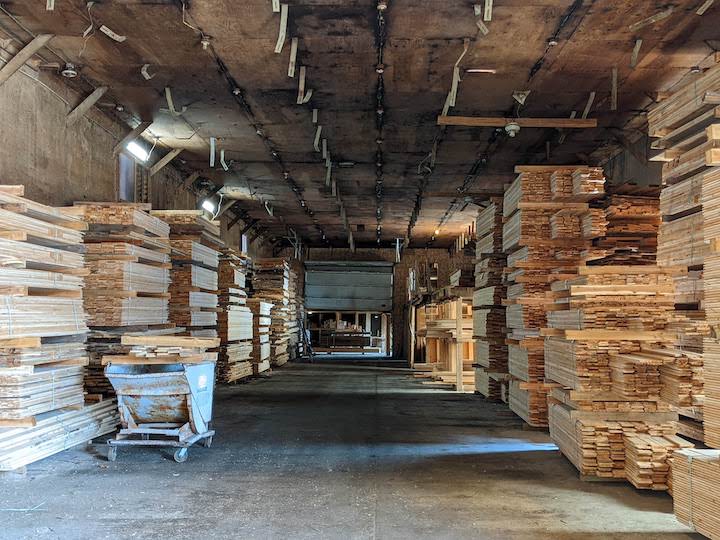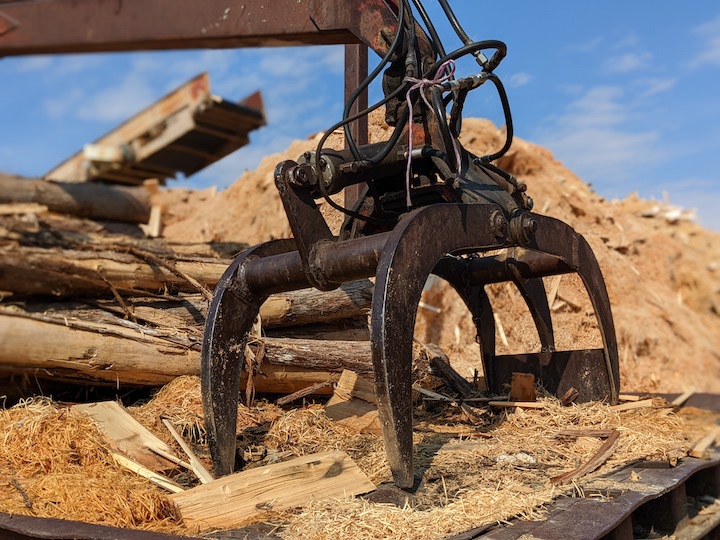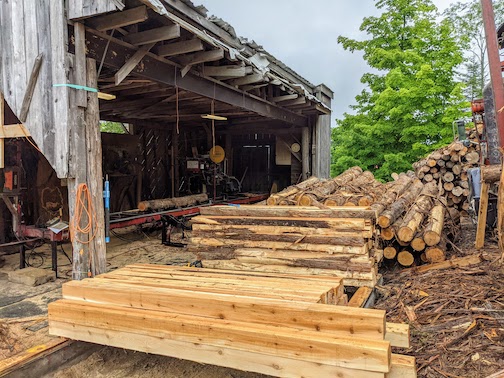By Noah Gleason-Hart
As MOFGA members, we all recognize that eating local, sustainably grown food is good for us, good for the environment, and good for our communities. However, we sometimes forget to extend our view beyond the field edge to see that local wood provides similar benefits.
“Know you farmer” is a catchphrase folks often use to encourage consumers to engage with the people and processers that produce the food they eat every day. We can apply the same concept to knowing the loggers and sawyers that produce your wood. When those folks live in your community and you buy from them, the same level of accountability exists as when you support the farmers in your neighborhood.

Local wood also has a much lighter carbon footprint. Trees harvested and milled in your town and then trucked just a few miles release far less carbon dioxide than wood transported across the state, nation or the world to reach you. Wood product production also helps keep forests intact. When you or your neighbor periodically sell logs from thoughtful harvests, it produces revenue that offsets the high annual costs of land stewardship, allowing forests to stay as forests rather than being converted to other uses. When these logs go to mills close by, it amplifies their economic impact by keeping dollars in what are often small, rural communities.
Finally, and perhaps most importantly, if we aren’t willing to produce forest products here, where are they coming from? Are we simply pushing the impacts of our consumption to less privileged communities? If we are not willing to engage in the production of a renewable resource, do we have a right to be using that resource at all?
More Than Local
Maine has a robust forest products industry, and we have large mills throughout the state that produce wood from Maine trees and sell it all over the state and the world. Buying local trees processed in this way is good, but as conscientious consumers committed to community economic development and stewardship of the forest resource, we can do better.

Drive down any backroad in the state, and you’ll see small sawmills dotting backyards and fields. Some are for personal use, but many produce wood products available for the community or provide mobile sawing services. These sawyers often buy their logs from a small logger that can provide them with occasional truckloads, or they may cut trees off their own land.
These mills may provide species, quality, and dimensions not seen at big-box stores, and they are certainly more available to answer your questions about how they source their wood.
Giving our business to these hyper-local operations is as vital as frequenting a nearby farmstand for summer vegetables.
Balance
To be clear: supporting local resource production does not mean that all timber harvesting is positive, or that society can ignore the difficult question of unsustainable consumption simply by producing more resources. Poorly conducted exploitative harvests happen every day, sometimes right in our neighborhoods, and we must live within ecological limits.
However, we have an opportunity to actively engage with many of our forests in ways that respect and enhance ecological processes and improve ecosystem resilience, while also producing products for human benefit. For the wood movement to succeed and be sustainable, it must support reduced societal consumption levels and make the case that logging and natural resource production are not inherently negative forces.
Finally, we must acknowledge that the forests we steward are the land of the Wabanaki, “the People of the Dawnland”: the Abenaki, the Maliseet, the Mi’kmaq, the Passamaquoddy and the Penobscot. We thank these tribal communities for caring for this land sustainably from time immemorial. We must also recognize that many conceptions of forest management — however well-intentioned — are intertwined with this country’s colonialist history. The local wood economy will not succeed if we do not incorporate equity in meaningful and concrete ways into the process.

Moving Forward
It’s important to remember that the rebirth of the local food movement took years of concerted effort by pioneering farmers, thoughtful consumers and hardworking nonprofits to bring to fruition. The local wood movement is in the early stages of this process, and — like the food movement in the 1970s — there’s much work to be done. For the movement to succeed, we must change prevailing narratives about forestry and logging, reinvigorate local wood awareness and recreate the infrastructure necessary for a local wood economy.
Other organizations, like Local Wood WORKS (LWW), and forward-thinking entrepreneurs across the state, have led the way by raising awareness about local wood and creating business models that center local values. With support from the Maine Timberland Charitable Trust, MOFGA’s low-impact forestry program is excited to contribute to these efforts in 2022. We are currently collaborating with LWW to expand their existing wood producer map, called the ”Maine Wood Guide,” to include more small sawmills and mobile operators so that consumers with a desire to have their own home-produced logs milled or buy local lumber can more easily connect with existing resources in their area.
Noah Gleason-Hart is MOFGA’s low-impact forestry specialist. You can contact him at [email protected].
This article was originally published in the summer 2022 issue of The Maine Organic Farmer & Gardener. For low-impact forestry workshops, check out MOFGA’s events calendar, or consider signing up for our monthly Low-Impact Forestry Newsletter.
